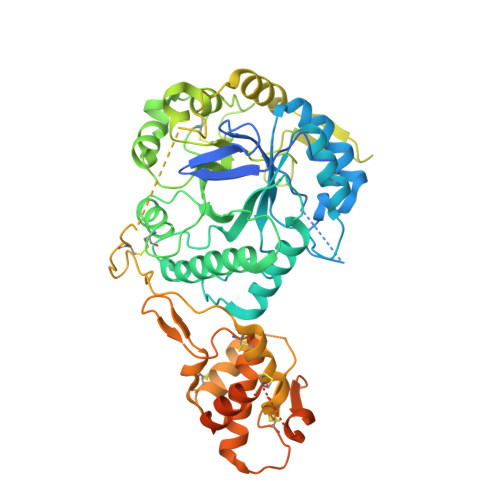A Trapped Covalent Intermediate of a Glycoside Hydrolase on the Pathway to Transglycosylation. Insights from Experiments and Quantum Mechanics/Molecular Mechanics Simulations.
Raich, L., Borodkin, V., Fang, W., Castro-Lopez, J., van Aalten, D.M., Hurtado-Guerrero, R., Rovira, C.(2016) J Am Chem Soc 138: 3325-3332
- PubMed: 26859322
- DOI: https://doi.org/10.1021/jacs.5b10092
- Primary Citation of Related Structures:
5FIH - PubMed Abstract:
The conversion of glycoside hydrolases (GHs) into transglycosylases (TGs), i.e., from enzymes that hydrolyze carbohydrates to enzymes that synthesize them, represents a promising solution for the large-scale synthesis of complex carbohydrates for biotechnological purposes. However, the lack of knowledge about the molecular details of transglycosylation hampers the rational design of TGs. Here we present the first crystallographic structure of a natural glycosyl-enzyme intermediate (GEI) of Saccharomyces cerevisiae Gas2 in complex with an acceptor substrate and demonstrate, by means of quantum mechanics/molecular mechanics metadynamics simulations, that it is tuned for transglycosylation (ΔG(⧧) = 12 kcal/mol). The 2-OH···nucleophile interaction is found to be essential for catalysis: its removal raises the free energy barrier significantly (11 and 16 kcal/mol for glycosylation and transglycosylation, respectively) and alters the conformational itinerary of the substrate (from (4)C1 → [(4)E](⧧) → (1,4)B/(4)E to (4)C1 → [(4)H3](⧧) → (4)C1). Our results suggest that changes in the interactions involving the 2-position could have an impact on the transglycosylation activity of several GHs.
Organizational Affiliation:
Departament de Química Inorgànica i Orgànica and Institut de Química Teòrica i Computacional (IQTCUB), Universitat de Barcelona , Martí i Franquès 1, 08028 Barcelona, Spain.
















